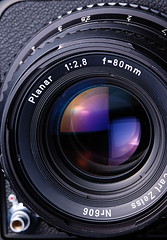 It is very easy to test the shutter speeds of your lens or camera. You simply record it while you press the shutter and analyze the duration of the shutter sound.
It is very easy to test the shutter speeds of your lens or camera. You simply record it while you press the shutter and analyze the duration of the shutter sound.I did this in order to check if my Zeiss Planar 80 mm f/2.8 lens was working correctly after its repair. Before the repair, 1 second nominal shutter speed lasted approximately 2 seconds (I did not test the exact shutter speed but it was obvious that it was too long because I could observe this with a watch!).
With old lenses, the shutter speeds in the range from 1/2 s to 1 s and 1/250 s to 1/500 s are often too slow and you have to add one or two thirds of a stop to the aperture in order to compensate for this. The intermediate speeds are usually okay.
I recorded the sound with a portable Zoom H2 MP3 recorder (it's no problem to use a Zoom in order to record fast primes!) at 48 kHz and 16 Bit. I used 48 kHz because it yields more samples and should be more accurate - at least theoretically. 44.1 kHz should also be fine. Of course any other microphone would also work.
 I set the shutter speed, pressed the mirror pre-release, announced the selected shutter speed and pressed the shutter button. I release the shutter button about half a second after the shutter closed so the sound of the auxilliary shutter is separated from the sound of the diaphragm shutter. I recorded each shutter speed three times in order to test if they vary from time to time. I tested all speed from 1 s to 1/500 s.
I set the shutter speed, pressed the mirror pre-release, announced the selected shutter speed and pressed the shutter button. I release the shutter button about half a second after the shutter closed so the sound of the auxilliary shutter is separated from the sound of the diaphragm shutter. I recorded each shutter speed three times in order to test if they vary from time to time. I tested all speed from 1 s to 1/500 s.Then I read the file into the computer and opened it with Audacity. Of course you can use any software that shows a time scale and has the ability to zoom into the track. The following image shows an example for the shutter speed of 1/2 s. The first noise is the mirror pre-release. The shutter is pressed at approximately 1:10.95 and closes at 1:11.5. Of course it is difficult to see where exacly the shutter opens and closes but I found the most reasonable values when I simply looked at the positions of the maximum peaks, in this case at 1:10.99 and 1:11.50. This means, the shutter opens for 510 milliseconds instead of the nominal 500 milliseconds. Thus it is only 2 % too slow. I think, this is pretty accurate for a mechanical shutter.

At 1:12.1 you see that the shutter button is released and the auxilliary shutter closes.
Please note that you need to compare your measured values to the acutal and not to the marked shutter speed (see table below). Use the right column in order to compare your results to the specified speed.
| Marked shutter speed (1/s) | Actual shutter speed (1/s) | Duration (ms) |
| 1 | 1 | 1000 |
| 2 | 2 | 500 |
| 4 | 4 | 250 |
| 8 | 8 | 125 |
| 15 | 16 | 62.5 |
| 30 | 32 | 31.3 |
| 60 | 64 | 15.6 |
| 125 | 128 | 7.8 |
| 250 | 256 | 3.9 |
| 500 | 512 | 1.95 |
| 1000 | 1024 | 0.98 |
For fast speeds, one needs to zoom much more into the audio file and it becomes harder to determine the position of the maximum peaks. For me it worked still at 1/500 s which is the maximum speed for this lens.
I found all shutter speeds of my lens to be correct within 10 %. This means I do not need to correct for this and close the aperture anywhere in order to compensate for this.
Testing the shutter speeds this way is relatively simple, inexpensive and precise.
Very nice post, thank you. I've used the sound recorded by a compact digital camera in video mode for the same purpose. The only problem was that Audacity would not open correctly the sound part of the movie. Mhwaveedit was a good tool for that (http://freshmeat.net/projects/mhwaveedit/).
ReplyDeletewow an interesting Idea. I may try this. :-) Thank you
ReplyDelete